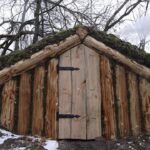How to Build a Figure-C Feral Hog Trap
This is a figure c trap that we actually builttodayAs you can see it has an inner C and an outerCThis outer C kind of serves as a drift fenceSo what happens is the pigs will end up circlingthe trap whenever they see baitAnd they’ll start circling and they will catchone of these drift fencesyou can see there’s one right here by me andthere is another one that’s on the other sideover there. So what happens is they’ll catch one of theseand they’ll start walking in and what we haveis a funnel on each sideAnd you can see this inner c has 4 foot thatis not attached to a t-post, it just worksas a funnel and it’s tension loaded basedoff of the paneland it springs shut once the hog has enteredthe trapThe same thing happens on the other side hereYou can see it can catch the drift fenceand it works it’s way in and then it endsup shutting back behind itSome of the things to note as you can seemost of the t-posts on the inner c are seton the exterior of the panelsthat’s because whenever the hogs are in thetrap they’re going to be pushing up againstthe panel which push up against the t-postWe’ve already wired the panels together forthe coral trapSo now what we’re going to do is we’re goingto stand them up and start to build the structureof the trapand then once we do that we’re going to putthe t-posts inso to do that you just got to stand it up onit’s end and then we’re going to walk theends in to kinda form a C because this isgonna be a figure-c with a tight c and a littlecSo now what we’re gonna do is we’re gonnaend up using some doubled over bailing wireto wire the t-posts to the actual panels ofthe corral trap and if you look here the t-postclipthat everybody uses normally for doing barbwire fences and fencing they usually willnot hold a hog because if you were to lookat the side right here were you bend the t-postclip around it actually doesn’t make a fullloop around that wire, the horizontal wireSo a lot of the times what happens is thehog will get in there and it will actuallybend that back up and pop it off the t-postso then the panel is looseSo what we like to use is actually just doubledover bailing wire and then wrap it arounditIf you notice whenever we’re doing the wiringwe’re using the doubled over bailing wireto wire the panels to the t-post and whenwe do it we’re actually wiring it and twistingit from the outside of the trap that way whenevera hog comes by its not gonna end up hittingthe twisted wire and possibly breaking itits just coming across the smooth side ofthe wire on the inside of the trap. This right here is actually all going to betightthis right here is going to end up being looseand its going to work as the funnelas you can see we bent about the last 4 footof the panels on the inside of the trap andthat last 4 foot is not gonna have a t-postset on it and as you can see the width atthe start of that bend whenever it comes evenwith the other panel is gonna be about roughlythe width of an average man which is probablygonna be about 24 inches or so wide and that’sprobably gonna be about the same width aswhat a hog is, you know 24 to about 30 inchesand that way the hog can start out at thesame width as their shoulder and then theycan just walk their way into the trapanother key point is you’re only going tohave one post here like I said four foot beforethe end of this inside panel and you wantto make sure that one’s set on the insideof this panel that way whenever the hogs comethrough they don’t end up hitting the t-postthey only end up hitting the panel and thenpush up against the t-postWhenever you actually go into baiting thetrap you’re going to want to bait most ofyour bait towards the exterior of the trapor the rear of the trap kind of right in thisarea here and you want a big pile herethe reason for that being that whenever you’reactually baiting them you want the hogs tocome in and stay in the back of the trap becauseyou don’t want them near the front of thetrap piling up and possibly figuring out howto get out againyou want a small line of bait starting atthe funnel here and then working through thefunnel into the trapand once they’re in the trap they’re worktheir way towards the back of the trap andadditional hogs will follow them in



